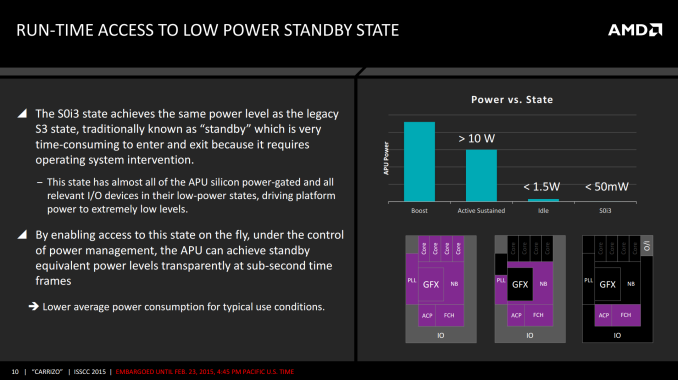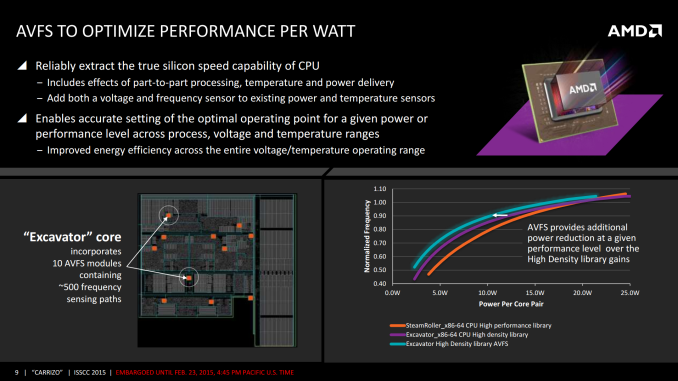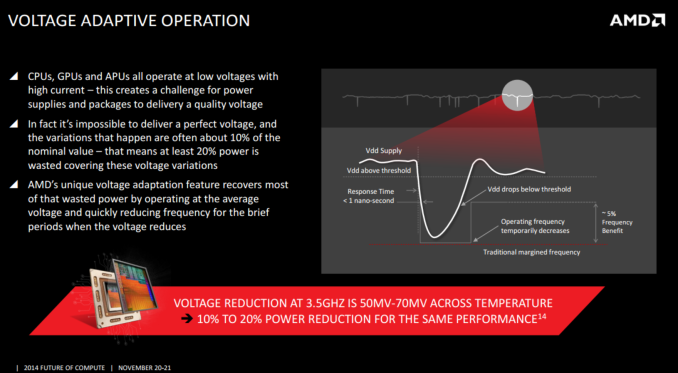AMD Launches Carrizo: The Laptop Leap of Efficiency and Architecture Updates
by Ian Cutress on June 2, 2015 9:00 PM ESTPower Saving and Power Consumption
When it comes to power, Carrizo features two/three technologies worth discussing. The first is the use of low power states, and the different frequency domains within the SoC. Previous designs had relatively few power planes, which left not as many chances for the SoC to power down areas not in use. Carrizo has ten power planes that can be controlled at run-time, allowing for what can be described as a dynamic race to sleep. This is bundled with access to the S0i3 power state, giving sub 50mW SoC power draw when in sleep and wake-up times under a second.
This is also combined with automated voltage/frequency sensors, of which an Excavator core has 10 each. These sensors take into consideration the instructions being processed, the temperature of the SoC, the quality of power delivery as well as the voltage and frequency at that point in order to relay information about how the system should adjust for the optimal power or performance point.
AMD states that this gives them the ability to adjust the frequency/power curve on a per-module basis further again to the right, providing another reduction in power or increase in frequency as required.
Next up for discussion is the voltage adaptive operation that was introduced back in Kaveri. I want to mention it here again because when it was first announced, I thought I understood it at a sufficient level in order to write about it. Well, having crossed another explanation of the feature by David Kanter, the reason for doing so clicked. I’m not going to steal his thunder, but I suggest you read his coverage to find out in more detail, but the concept is this:
When a processor does work, it draws power. The system has to be in a position to provide that power, and the system acts to restabilize the power while the processor is performing work. The work being done will cause the voltage across the processor to drop, to what we classically call Voltage Droop. As long as the droop does not cause the system to go below the minimum voltage required for operation, all is good. Voltage Droop works if the supply of power is consistent, although that cannot always be guaranteed – the CPU manufacturer does not have control over the quality of the motherboard, the power supply or the power conversion at hand. This causes a ripple in the quality of the power, and the CPU has to be able to cope with these ripples as these ripples, combined with a processor doing work, could cause the voltage to drop below the threshold.
The easiest way to cope is to put the voltage of the processor naturally higher, so it can withstand a bigger drop. This doesn’t work well in mobile, as more voltage results in a bigger power draw and a worse experience. There are other potential solutions which Kanter outlines in his piece.
AMD has tackled the problem is to get the processor to respond directly. When the voltage drops below a threshold value, the system will reduce the frequency and the voltage of the processor by around 5%, causing the work being done to slow down and not drain as much. At AMD’s Tech Day, they said this happens in as quickly as 3 cycles from detection, or in under a nanosecond. When the voltage drop is normalized (i.e. the power delivery is a more tolerable level), the frequency is cranked back up and work can continue at a normal rate.
Obviously the level of the threshold and the frequency drop will determine how much time is spent in this lower frequency state. We were told that with the settings used in Carrizo, the CPU hits this state less than 1% of the time, but it accounts for a sizeable chunk of overall average power reduction for a 3.5 GHz processor. This may sound odd, but it can make sense when you consider that the top 5% of the frequency is actually the most costly in terms of power than any other 5%. By removing that 5% extreme power draw, for a minimal performance loss (5% frequency loss for sub 1% of the time), it saves enough power to be worthwhile.













137 Comments
View All Comments
D. Lister - Wednesday, June 3, 2015 - link
Calling an unlaunched product "bad" would be just as imprudent as calling it "good", but then what do I know, fortune-telling could be just another one of your super powers, along with mind-reading.Gigaplex - Thursday, June 4, 2015 - link
Why would they use an Intel chip to fake a bar graph? Just put fake numbers directly into a spread sheet, job done.Dirty_Punk - Wednesday, June 3, 2015 - link
Unfortunatelly, time to market, as always for AMD, will be probably 6 month or more... at that time there will be something better from intel. It seems a lot like Asus from this point of view, grat product and very bad supply chain.AMD has 3 problems ritght now:
1- with 28nm is difficult to compete against 14nm of intel
2- very slow from project design to mass production
3- no support from OEM and major system builders (HP & co.), as it seems always that Intel works to force system builder to forget about AMD like years ago...
jabber - Wednesday, June 3, 2015 - link
Yep this time next year when you walk into a PC store you'll still see 25 Intel laptops and one cheap nasty AMD laptop on the shelves. OEMs don't care about AMD anymore. From what I see from customers is, that they only buy AMD if they are the cheapest machine in the shop. And then its a E1 chip and the customer really regrets it.haukionkannel - Wednesday, June 3, 2015 - link
That problem 1 is the worst! AMD APUs are ok, but 28nm vs Intel 14nm is just a huge deal. When considering power and efficiency and how much they can put on the chip.jimjamjamie - Wednesday, June 3, 2015 - link
HP is actually pretty good for offering a good selection of AMD-powered laptops, usually the cheaper models. Better than most other OEMs though.bloodypulp - Wednesday, June 3, 2015 - link
The only decent laptops HP makes are the Elitebooks. And you will pay through the nose for them when you can get better quality from other brands for less. HP should just stop making PCs, period.UtilityMax - Wednesday, June 3, 2015 - link
HP has several models with AMD chips. It's one of them few laptop makers that allows you to configure an Envy laptop with say a 1080p screen, SSD, a A10 CPU, plus discrete graphics.jabber - Thursday, June 4, 2015 - link
And I bet they sell about 8 of those AMD based machines a year.watzupken - Thursday, June 11, 2015 - link
Point 2 is probably their killer to be honest. Point 1 is definitely puts AMD in a disadvantage, but considering that Intel don't seem to be interested in pushing performance since its Sandy Bridge days, it's giving AMD a chance to catch up in terms of performance.To be honest, I think I have to take my hat off AMD's efforts. At 28nm, they are forced to be as creative as they can to squeeze performance out, while keeping power requirements in check.